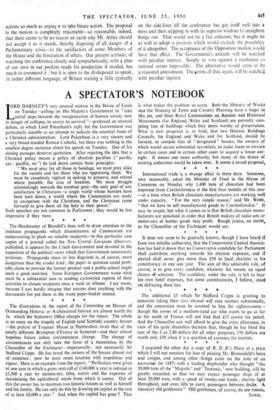The illustrations in the report of the Committee on Houses
of Outstanding-Historic or Architectural Interest are almost worth the 3s. which the Stationery Office charges for the report. The whole is an essay on the tragedy of English (and Scottish) country houses —the picture of Traquair House in Peeblesshire rivals that of the totally different Brympton d'Evercy in Somerset—and their almost hopeless future unless circumstances change. The change of circumstances can only take the form of a recantation by the Chancellor of the Exchequer—impersonally ; not necessarily Sir Stafford Cripps. He has taxed the owners of the houses almost out of existence ; now he must remit taxation with expedition and vigour. Here is an example from the report: "Particulars were given of one case in which a gross rent-roll of £140,000 a year is reduced to £3,500 a year by income-tax, tithe, surtax and the expenses of maintaining the agricultural estate from which it comes. Out of this the owner has to maintain two historic houses as well as himself and his family. He can only do this by drawing on capital at the rate of at least £8,000 a year." And when the capital has gone ? That
is what makes the problem so acute. Both the Ministry of Works and the Ministry of Town and Country Planning have a finger in this pie, and three Royal Commissions on Ancient and Historical Monuments (for England, Wales and Scotland) are patiently com- piling lists of buildings which they deem worthy of preservation. What is now proposed is, in brief, that two Historic Buildings Councils, for England and-Wales and for Scotland, should be formed, to compile lists of " designated " houses, the owners of which would secure substantial tax-reliefs, to make loans to owners in certain cases and in certain other cases to acquire a house out- right. It means one more authority, but many of the duties of existing authorities would be taken over. It seems a sound proposal
* * * *


































 Previous page
Previous page